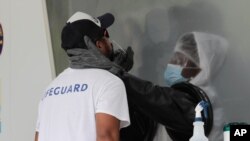COVID-19 tests that take an hour or less and can be done at doctors’ offices, workplaces, or even at home are under development.
They could have a big impact on the course of the pandemic in the United States, where long lines for tests and long waits for results are undermining efforts to control the disease.
People who get tested for the coronavirus that causes COVID-19 have been waiting for days, up to a week in some places, to find out if they are infected, as overloaded labs struggle to keep up with demand.
Patients can spread the virus while they are waiting for test results. That's also a setback for public health workers who need to identify patients' contacts and isolate them before the virus spreads further. Plus, patients tested one day can be infected the next, while they are waiting for results.
"If you get the results back a week later, those results are effectively a historical record. They're not actionable information," said Zev Williams at Columbia University.
Testing has taken on extra urgency in the COVID-19 pandemic because roughly half of infections may be spread from people with no symptoms, according to some estimates.
Frequent, widespread and fast
Current assays require certified laboratories with expensive, specialized equipment and trained personnel. Labs have run into shortages of chemicals, the special cartridges some machines use, and even the long swabs that health workers insert deep into patients' noses to get samples.
"Testing has to be frequent, widespread and fast," Williams said. It should be fast enough so people can take a test and get results before they get on an airplane, enter a nursing home, or go to school, he said.
Some companies are aiming to develop simple tests patients could do at home. That would eliminate many of the supply issues, as well as keep patients safe and prevent them from exposing anyone else.
"Bringing testing home can help solve just about every aspect of how we manage this pandemic," said Sherlock Biosciences CEO Rahul Dhanda, "as long as a test can be accurate and dependable."
Sherlock is developing a test called INSPECTR that looks and functions like a home pregnancy test. The user applies a bit of saliva to a strip of paper in a plastic holder. In about half an hour, the paper changes color if the user is infected. Dhanda says it should cost no more than $30. The company hopes to have the test on the market in the first half of next year.
Sherlock is also working on a system that could run in pharmacies, grocery stores, nursing homes or just about anywhere else with a power supply. It runs on a machine developed by medical device company Binx that is currently used in clinics and doctors' offices to test for sexually transmitted infections. Patients would spit in a tube and get results in half an hour.
Sherlock hopes to have the system up and running in the fall. It's based on an approach the company is using in a Food and Drug Administration-approved test. That test uses CRISPR, a system best known for gene editing, to identify specific genetic fingerprints of the virus.
The scientists behind the technology, including Sherlock's co-founders, put a low-cost open-source version online at STOPCovid.science. All the reaction components are contained in one tube. Saliva or a mouth swab go in the tube, which then sits at 60 degrees Celsius for half an hour. Dip a paper test strip in the tube, and yes-or-no results show up in a few minutes.
It is not FDA approved, and it is not intended for clinical testing, but the researchers say the aim is to help move the technology forward.
Repurposed fertility test
Columbia's Williams helped develop a similar assay. In an example of how COVID-19 has scrambled everyone's priorities, Williams is not an infectious disease doctor. He heads the Division of Reproductive Endocrinology and Infertility at the university medical center.
He said one way to test prospective parents who are having trouble conceiving is to look for genetic defects that can cause infertility.
"In terms of the underlying molecular biology, it's not that different" to look for a fertility gene or the genes of a virus, he said.
But overhauling the fertility test to look for the coronavirus in saliva, and doing it in such a way that it could be done easily without special equipment or training was a challenge.
"It actually took an enormous amount of work to make it very simple," he said.
Like the STOPCovid test, all the reactions take place in one tube. The only special equipment they need is a heating block or hot water kept at 60 degrees Celsius. But instead of getting results on a strip of paper, this test is based on color. The red test solution turns yellow if the sample contains virus.
All of the test makers say their assays are as accurate as those done at major labs today, but the FDA has not yet evaluated any of them. Only one test, Sherlock and Binx's, has a commercial partner to scale up manufacturing.
Williams said his group is working to get their test to market "as quick as possible. I'll tell you, it's something we push on every single day."
"You just see how the problems are not getting less," he said. "They're growing and growing, and the need for this is growing."





